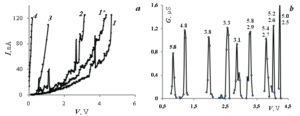Properties of Indium Antimonide Nanocrystals as Nanoelectronic Elements
The Quantum Potential of Indium Antimonide Nanocrystals in Nanoelectronics
Recent advancements in nanoelectronics have highlighted the potential of indium antimonide (InSb) nanocrystals as foundational elements in high-performance quantum devices. In a new study published in IgMin Research, Nikolai Zhukov explores the unique properties of these nanocrystals, focusing on their potential for use in single-electron transistors, memristors, and photon bolometers. This post examines the study’s findings and the innovative applications for InSb nanocrystals in the field of nanoelectronics.
Key Properties of Indium Antimonide Nanocrystals
Indium antimonide nanocrystals demonstrate quantum size effects, where electron behavior is restricted within the crystal structure, leading to unique conductivity and photonic properties. These quantum-sized particles offer several significant advantages:
- Quantum Conductivity
-
- The study measured the current-voltage characteristics of single InSb nanocrystals, revealing distinct peaks and periodic oscillations attributed to Bloch oscillations within the quantum well. This behavior suggests their suitability for high-precision electronic components in nanoelectronic devices.
- Single-Photon Emission and Entangled Photons
-
- Zhukov’s research found evidence of single-photon emissions from InSb nanocrystals, with properties similar to entangled photons. This characteristic could enable applications in secure quantum communication and optoelectronic devices.
- Applications in Memristors and Transistors
-
- The research proposes using InSb nanocrystals in electronic memristors, where they retain memory states through electron injection and removal processes. Such nanocells could form the basis of single-electron transistors and other high-speed, low-power nanoelectronic elements.
Potential Applications in Nanoelectronics
- Quantum Computing: InSb nanocrystals’ ability to function as quantum oscillators may allow for applications in quantum memory and computing devices.
- Photon-Based Sensors: Their single-photon emission capabilities could support advanced sensing technologies for high-resolution imaging and detection.
- Secure Communication: Entangled photons produced by InSb nanocrystals have potential applications in quantum encryption, providing enhanced security for data transmission.
Conclusion:
This study underscores the potential of indium antimonide nanocrystals as versatile components in nanoelectronics. From quantum computing to secure communications, InSb nanocrystals represent a promising material for the next generation of electronic and photonic devices.
To explore the full study, visit IgMin Research or access the DOI: 10.61927/igmin134.
Tags:
Indium Antimonide, Nanocrystals,Quantum Conductivity, Nanoelectronics, Single-Photon Emission, Quantum Devices, IgMin Research, Memristors.

a: Current-voltage characteristic: 1.1*.2 – NC-InSb; 3 – submicro-InSb test; 4 – ITO test; b – Conductivity peaks, numbers above the curves – calculated values of dimensions an for cases k = 1 (single and bottom) and k = 2
